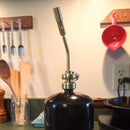Introduction: $25 DIY LED Strip Grow Light
I wanted a bright light to help start my seedlings in the spring. There are two variation to this project, one with a heat sink and one without. The photos are for the heat sink version since that is what I made.
Parts
- Flexible LED Strip ($7.19 for 5630 type, over 4000 lumens)
- Power Supply ($8.96 for a 12V 6A unit)
- Planting Tray ($4.50 for one at Walmart)
- Outlet Timer ($4 for the best deal at Home Depot)
Optional:
- Strip Connector($2.68 if you are scared to use a soldering iron)
- Cookie Sheet ($7 at IKEA for a "Heat Sink")
- Dimmer ($5 if you want the ability to adjust brightness/heat of the LED's)
Step 1: Cut, Measure, and Attach.
If you are going to attach the strips to the humidity dome of your seed tray. Measure out the strips to fit inside the dome with some space for wires to connect the strips.
If you want to use a heat sink, then use a cookie sheet that fits on top of the humidity dome. Then measure and attach the strips on the cookie sheet. (Its warm where I live all the time so the heat sink helps dissipate the heat generated by the diodes. It also helps them last longer, running at full brightness I measured them at 60C.)
Cut the strips along the copper "cut points".
Attach the strips using the double sided tape that it comes with.
Step 2: Connect Lights
If you are opposed to getting a soldering iron then use some connectors to get all the strips attached. Then when you wire up at the end be sure to attach the positive (red +) on one end of the series and the negative (black -) to the other end. This will ensure that all the LED's will be similar in brightness. If you are using a full 5 meter (16.4ft) strip inside that dome the ones on the end will end up being dim if you don't.
If you can use a soldering iron then grab some scrap wire (at least 22AWG) and connect all the wires on one end to the positive and the other end to the negative (see the photos). This will equally distribute the power to every strip.
Step 3: Adjust & Time
If you want to adjust the brightness of the lights you can get one of these. I like using one for making the light a little less bright for seedlings then ramping it up before they go outside (mimicking the seasonal change).
Plug your power supply into an outlet timer. Set the schedule between 10-16 hours a day depending on what you are starting and where you live.
I live in Phoenix where we plant in February. So if I were to start seeds in December would choose 11 hours of light, because that is the amount of light hours in February here. The further north you are the more hours you will need to compensate for the late start. June seed starts in Phoenix would be 14 hours.











